|
Books Should Be Free Loyal Books Free Public Domain Audiobooks & eBook Downloads |
|
|
Books Should Be Free Loyal Books Free Public Domain Audiobooks & eBook Downloads |
|
Top Authors |
|---|
|
Book type:
Sort by:
|
By: Henry James (1843-1916) | |
|---|---|
 Greville Fane
Greville Fane
| |
 Nona Vincent
Nona Vincent
| |
 Louisa Pallant
Louisa Pallant
| |
By: Jacob & Wilhelm Grimm (1785-1863; 1786-1859) | |
|---|---|
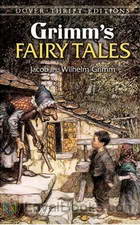 Grimms' Fairy Tales
Grimms' Fairy Tales
Talking animals, wicked stepmothers, valiant tailors, cruel witches! Sixty-two stories that feature familiar figures like Hansel and Gretel, Rapunzel, Rumplestiltskin, The Twelve Dancing Princesses and Snow-White and Rose Red as well as lesser-known characters like The White Snake, Sweetheart Roland and Clever Elsie are contained in this volume of Grimms' Fairy Tales by Jacob and Wilhelm Grimm. The original volume published in 1812 contained more than 85 tales and this number kept increasing till it got to the seventh edition which contained more than two hundred stories... | |
By: Jacob Grimm (1785-1863) | |
|---|---|
 Household Stories by the Brothers Grimm
Household Stories by the Brothers Grimm
| |
By: John B. Bury (1861-1927) | |
|---|---|
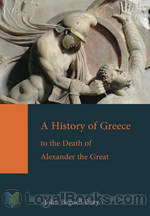 A History of Greece to the Death of Alexander the Great
A History of Greece to the Death of Alexander the Great
For the Irish historian John Bagnell Bury, history should be treated as a science and not a mere branch of literature. Many contemporary histories written in the late nineteenth and early twentieth century were poetic and heroic in tone, blending fact and fiction, myths and legends. They sometimes relied on sources from Shakespeare and classical poets. For Bury, the facts of history may be legendary or romantic in nature, but they should be recounted in a scholarly and non-judgmental manner, without the accompanying emotions... | |
 The Students' Roman Empire
The Students' Roman Empire
The writings of J. B. Bury (1861-1927), on subjects ranging from ancient Greece to the 19th-century papacy, are at once scholarly and accessible to the layman. This work covers the period from the beginning of the Roman Empire until Gibbon begins; from Augustus through Marcus Aurelius and the Antoinine Emporers. | |
By: Jonathan Swift (1667-1745) | |
|---|---|
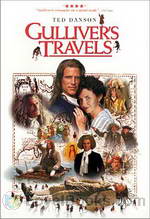 Gulliver's Travels
Gulliver's Travels
Comprised of four parts, Gulliver’s Travels documents the bizarre, yet fascinating voyages of Lemuel Gulliver as he makes his way through several uncharted destinations, experiencing the lives of the small, the giant, the scientific, and downright eccentric societies. Narrated in first person, Swift successfully portrays Gulliver’s thoughts and reactions as he faces struggles of integration throughout his travels. Beginning with the introduction of Gulliver, an educated ship’s surgeon, who after a series of unfortunate events is victim to repeated shipwrecks, desertions, and set adrift... | |
 A Modest Proposal
A Modest Proposal
A satirical essay written by one of the most renowned satirists, Jonathan Swift, A Modest Proposal expresses the author’s exasperation with the ill treatment of impoverished Irish citizens as a result of English exploitation and social inertia. Furthermore, Swift ventilates the severity of Ireland’s political incompetence, the tyrannical English policies, the callous attitudes of the wealthy, and the destitution faced by the Irish people. Focusing on numerous aspects of society including government exploitation, reckless greed, hypocrisy, apathy, and prejudice, the essay successfully exemplifies Swift’s satirical skills... | |
 Gulliver's Travels Into Several Remote Regions of the World
Gulliver's Travels Into Several Remote Regions of the World
| |
 Tale of a Tub
Tale of a Tub
A Tale of a Tub was the first major work written by Jonathan Swift, composed between 1694 and 1697, that was eventually published in 1704. It is arguably his most difficult satire, and perhaps his most masterly. The Tale is a prose parody which is divided into sections of "digression" and a "tale" of three brothers, each representing one of the main branches of western Christianity. A Tale was long regarded as a satire on religion itself, and has famously been attacked for that, starting with William Wotton... | |
 Three Sermons: I. on mutual subjection. II. on conscience. III. on the trinity
Three Sermons: I. on mutual subjection. II. on conscience. III. on the trinity
| |
 Poems of Jonathan Swift, Volume One
Poems of Jonathan Swift, Volume One
Sit back and listen to these light-hearted witty rhymes and see the world Jonathan Swift saw -- and maybe recognize your own. Think there is such a thing as corrupt rich guys who pretend they're God's gift to the world? So did Swift. Think some of these types strut around as if calls of nature don't apply to them? So did Swift. In one hilarious poem, he even describes gold diggers fighting over the loaded gentleman's gaseous offerings! His poem On Poetry, A Rhapsody, censored for treasonous mocking of the royal family, is in its rare uncensored form here... | |
 The Journal to Stella
The Journal to Stella
| |
 Bickerstaff-Partridge Papers
Bickerstaff-Partridge Papers
| |
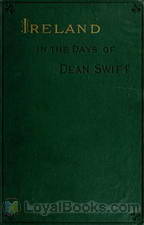 Ireland in the Days of Dean Swift Irish Tracts, 1720 to 1734
Ireland in the Days of Dean Swift Irish Tracts, 1720 to 1734
| |
By: Jean de La Fontaine (1621-1695) | |
|---|---|
 Fables in Rhyme for Little Folks
Fables in Rhyme for Little Folks
Several of La Fontaine’s fables, translated into English by W. T. Larned. | |
 Fables of La Fontaine — a New Edition, with Notes
Fables of La Fontaine — a New Edition, with Notes
| |
 Old Man and the Ass
Old Man and the Ass
LibriVox volunteers bring you 8 recordings of The Old Man and the Ass by Jean de La Fontaine. (There was no translator acknowledged in the text.) This was the Weekly Poetry project for July 7, 2013.Jean de La Fontaine was the most famous French fabulist and one of the most widely read French poets of the 17th century. He is known above all for his Fables, which provided a model for subsequent fabulists across Europe and numerous alternative versions in France, and in French regional languages.According to Flaubert, he was the only French poet to understand and master the texture of the French language before Hugo... | |
 The Original Fables of La Fontaine Rendered into English Prose by Fredk. Colin Tilney
The Original Fables of La Fontaine Rendered into English Prose by Fredk. Colin Tilney
| |
 Quotes and Images From The Tales and Novels of Jean de La Fontaine
Quotes and Images From The Tales and Novels of Jean de La Fontaine
| |
By: Anthony Trollope (1815-1882) | |
|---|---|
 Barchester Towers
Barchester Towers
Second in the series of novels set in the fictional cathedral town of Barchester, the reader is treated to a hilarious, if unseemly, competition for domination of the diocese! The contenders in Barchester Towers are Mrs. Proudie the wife of the mild, sadly henpecked bishop and Mr. Slope his slimy and devious chaplain. When the beloved former bishop suddenly dies, a complete outsider is brought in to take his place. Instead of the bishop's son, Archdeacon Grantly, whom the entire parish was expecting, a more low-church minister, Bishop Proudie is given the post... | |
 Can You Forgive Her?
Can You Forgive Her?
The first book in the political Palliser series, the novel deals with parliamentary politics, while concurrently devoting its pages to much more intricate issues. Presenting three parallel stories, the parliamentary novel draws its attention to three contrasting young women, who are beset with arduous decisions concerning courtship and marriage. Additionally, the novel covers topics including women in conventional society and their discernment, while illustrating the tentative stages of marriage with all the attributes of sacrifice, compromise and temptation... | |
 The Warden
The Warden
Published in 1855, The Warden is the first installment in Trollope’s highly acclaimed series Chronicles of Barsetshire, and offers an enlightening insight into the life of the Victorian clergy, its gentry, politics, and social settings. The novel focuses on Mr. Harding, an elderly clergyman who finds himself in the center of a vehement dispute over his questionable position as warden of Hiram’s Hospital. Exploring various themes including human nature, morals, reform, and manners, The Warden is a perfect representation of the structure of Victorian society... | |
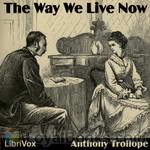 The Way We Live Now
The Way We Live Now
The Way We Live Now is a scathing satirical novel published in London in 1875 by Anthony Trollope, after a popular serialization. It was regarded by many of Trollope’s contemporaries as his finest work. One of his longest novels (it contains a hundred chapters), The Way We Live Now is particularly rich in sub-plot. It was inspired by the financial scandals of the early 1870s, and lashes at the pervading dishonesty of the age, commercial, political, moral, and intellectual. It is one of the last memorable Victorian novels to have been published in monthly parts. | |
 The Eustace Diamonds
The Eustace Diamonds
Lizzie Greystock, a fortune-hunter who ensnares the sickly, dissipated Sir Florian Eustace, is soon left a very wealthy widow and mother. While clever and beautiful, Lizzie has several character flaws; the greatest of these is an almost pathological delight in lying, even when it cannot benefit her. Before he dies, the disillusioned Sir Florian discovers all this, but does not think to change the generous terms of his will. The diamonds of the book’s title are a necklace, a Eustace family heirloom that Sir Florian gave to Lizzie to wear... | |
 Phineas Finn
Phineas Finn
Phineas Finn is the sequel to “Can you Forgive Her?” and the second novel in Trollope’s Palliser series. The eponymous hero is a young Irishman who becomes a member of the English parliament. Trollope aspired to become an M.P. himself, and he ably describes the workings of the English political scene. There is also a love interest, as the somewhat inconstant Phineas courts three different women: his Irish sweetheart, Mary Flood Jones; Lady Laura Standish, the daughter of a prominent Whig politician; and a lovely heiress, Violet Effingham. | |
 Ayala's Angel
Ayala's Angel
Lucy and Ayala Dormer are left penniless by the death of their parents. Ayala is taken in by their rich aunt Lady Tringle and Lucy by their poor uncle Mr Dosett. The girls find it hard to get used to their new surroundings. Lucy becomes engaged to one of her father’s artist friends but they are too poor to marry. Three different men fall in love with Ayala but none live up to her ideal of the perfect man. Will Lucy be able to marry her sweetheart and will Ayala find her ‘Angel of Light’? For the answers to these and many other questions, read this book. | |
 The Life of Cicero
The Life of Cicero
Marcus Tullius Cicero (106-43BC) was an orator, statesman, philosopher and prolific correspondent, who rose as a ‘new man’ in Rome in the turbulent last years of its republican government. Anthony Trollope, best known as a novelist, admired Cicero greatly and wrote this biography late in life in order to argue his virtues against authors who had granted him literary greatness but questioned his strength as a politician and as a man. He takes a personal approach, affording us an insight into his own mind and times as well as those of his subject... | |
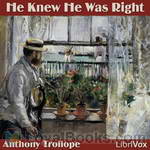 He Knew He Was Right
He Knew He Was Right
He Knew He Was Right is a 1869 novel written by Anthony Trollope which describes the failure of a marriage caused by the unreasonable jealousy of a husband exacerbated by the stubbornness of a wilful wife. As is common with Trollope’s works, there are also several substantial subplots. Trollope considered this work to be a failure; he viewed the main character as unsympathetic, and the secondary characters and plots much more lively and interesting. | |
 Phineas Redux
Phineas Redux
Phineas Redux is the fourth in Trollope’s series of six Palliser novels. At the end of Phineas Finn, the second novel in the series, Phineas had to return to Ireland to marry his childhood sweetheart, who was expecting their child. As Phineas Redux opens, Phineas is working as a Poorhouse Inspector in Ireland. His wife having died in childbirth, he finds his existence dull and unsatisfying. Phineas’ returns to England; his career advances and his romantic adventures continue, while we encounter many familiar characters including Glencora and Plantagenet Palliser, Madame Goesler, and Lizzie Eustace and her husband the Reverand Mr. Aemelius. | |
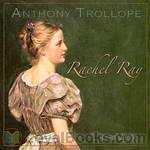 Rachel Ray
Rachel Ray
The love that develops between Luke Rowan and Rachel Ray is not universally welcomed. Mrs. Tappitt- a rich, influential, and bad woman - wishes him to marry one of her own daughters, while Rachel's mother and older sister are not sure he is worthy of her. After many adventures, everybody gets what they deserve. Characteristically to Trollope's works, there is also a secondary plot involving the election of parliament in Baslehurst."Summary by Stav Nisser.The book lives still because of its delicate little scenes of comedy, the meeting of the lovers, Mrs. Tappitt's ball, the bedroom confidences of the Tappitts, Rachel's talks with her mother." -Walpole | |